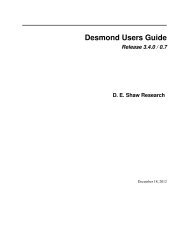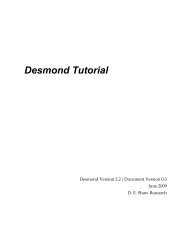Desmond Tutorial
Desmond Tutorial - DE Shaw Research
Desmond Tutorial - DE Shaw Research
- No tags were found...
You also want an ePaper? Increase the reach of your titles
YUMPU automatically turns print PDFs into web optimized ePapers that Google loves.
1 <strong>Desmond</strong> <strong>Tutorial</strong><br />
Introducing <strong>Desmond</strong><br />
<strong>Desmond</strong> is an advanced classical molecular dynamics simulation system, which has an<br />
intuitive graphical user interface integrated in the Maestro molecular modeling environment.<br />
Using <strong>Desmond</strong>, you can perform in silico simulations of small molecules, proteins,<br />
nucleic acids, and membrane systems to study the interactions of complex molecular<br />
assemblies. With <strong>Desmond</strong>, you can generate high‐quality simulation trajectories of long<br />
time scales as well as compute a variety of thermodynamic quantities. <strong>Desmond</strong> trajectories<br />
can be visualized and analyzed using numerous tools in Maestro and VMD.<br />
This tutorial assumes a basic knowledge of molecular mechanics and molecular dynamics.<br />
For those users who have not yet used Maestro for molecular modeling, an overview<br />
of the Maestro environment is included.<br />
Beyond basic molecular modeling, there are a number of steps that must be performed on<br />
a structure to make it viable for simulation with <strong>Desmond</strong>. Each of these steps mandates<br />
an understanding of certain concepts and differing approaches that can be taken.<br />
To enable novices and advanced users alike to process the information in this tutorial, the<br />
organization of the tutorial includes:<br />
• A step‐by‐step example that describes, at a high level, how to perform a simulation on<br />
a simple protein.<br />
• In‐depth concept sections that cover the detailed information users will need in order<br />
to perform a simulation similar to our example.<br />
This tutorial also includes conceptual information and steps for performing free energy<br />
perturbation (FEP) calculations. FEP is useful for performing “alchemical” ligand mutations<br />
to determine binding free energy differences, which is a crucial task for such applications<br />
as computational drug design.<br />
September 2008 D. E. Shaw Research 1






